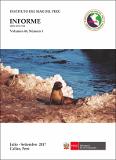Por favor, use este identificador para citar o enlazar este ítem:
https://hdl.handle.net/20.500.12958/3225| Título : | Monitoreo biológico poblacional del recurso “camarón de río” Cryphiops caementarius (Molina, 1782) en los ríos Majes-Camaná y Ocoña. 2015 |
| Otros títulos : | Biological and population monitoring of the resource “river shrimp” Cryphiops caementarius (Molina 1782) in the Majes-Camana and Ocoña Rivers. 2015 |
| Autor : | Campos León, Sarita Pinazo B., Kristhian Gutiérrez, Pablo Quiroz Ruiz, Marco |
| Palabras clave : | Camarón de río;Cryphiops caementarius;Crustáceos;Arequipa - Río Majes;Arequipa - Río Camaná;Arequipa - Ocoña |
| Fecha de publicación : | 2017 |
| Editorial : | Instituto del Mar del Perú |
| Citación : | Inf Inst Mar Perú 44(3), 2017, p. 442-448 |
| Citación : | Informe IMARPE;44(3), 2017 |
| Resumen : | Se reportan aspectos biológicos y poblacionales en base al seguimiento mensual efectuado en los
ríos de Majes – Camaná y Ocoña durante el año 2015. La estructura por tallas fluctuó entre 42 y 135 mm
de longitud total en el río Majes-Camaná y entre 43 a 152 mm en el río Ocoña; el porcentaje de ejemplares
menores a la talla mínima de captura (TMC= 70 mm) fue de 38,2% en el río Majes-Camaná y 32,4% en
río Ocoña. La proporción sexual en los ejemplares del río Majes-Camaná se vio alterada encontrándose
mayor proporción de hembras a mayores altitudes, en el río Ocoña estos valores coincidieron con el patrón
establecido. Por medio del análisis de madurez gonadal, se realizó el seguimiento de la evolución de la
condición reproductiva durante marzo y diciembre, reportándose para los dos ríos ejemplares hembras
con predominancia en estadio II (maduración incipiente) en los meses de marzo, mayo, agosto y setiembre;
y hembras en estadio en maduración intermedia, avanzada y post desove en los meses de noviembre y
diciembre. La mayor incidencia de hembras ovígeras se registró en diciembre en ambos ríos. El CPUE (kg/h)
mostró valor promedio anual de 2,365 y 4,311kg/2hr en los ríos Majes-Camaná y Ocoña, respectivamente. ABSTRACT: Biological and population aspects are reported, based on the monthly monitoring carried out in the Majes-Camana and Ocoña rivers during the year 2015. The size structure fluctuated between 42 and 135 mm of total length in the Majes-Camana River and between 43 and 152 mm in the Ocoña River; the percentage of specimens smaller than the minimum catch size (MCS = 70 mm) was 38.2 and 32.4% for the Majes-Camana and Ocoña rivers, respectively. The sex ratio in the Majes-Camana River was altered, with a higher proportion of females at higher altitudes. On the Ocoña River, these values coincided with the established pattern. Through the analysis of gonadal maturity, the evolution of the reproductive condition was monitored during March and December, reporting for the two rivers female individuals with stage II (incipient maturation) predominance in the months of March, May, August and September; and females in intermediate, advanced maturation and post spawning maturity in the months of November and December. The highest incidence of ovigerous females occurred in December in both rivers. CPUE (kg/h) showed an annual average value of 2,365 and 4,311 kg/2hr in the Majes-Camana and Ocoña rivers, respectively. |
| URI : | https://hdl.handle.net/20.500.12958/3225 |
| ISSN : | 03787702 |
| Aparece en las colecciones: | Informe vol. 44(3) 2017 |
Ficheros en este ítem:
| Fichero | Descripción | Tamaño | Formato | |
|---|---|---|---|---|
| Informe 44(3)9.pdf | 3,43 MB | Adobe PDF |  Visualizar/Abrir |
Este ítem está sujeto a una licencia Creative Commons Licencia Creative Commons

